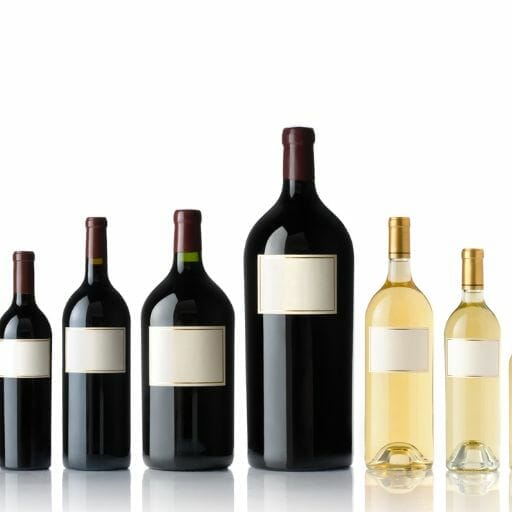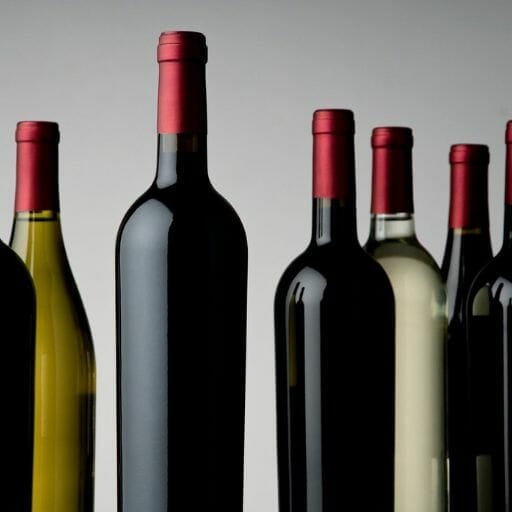How many liters in a bottle of wine? The standard wine bottle is 750 millilitres (ml), while Magnum bottles are 1.5 liters. But what about the Nebuchadnezzar and Solomon bottles? What if you want to buy wine by the bottle and you don’t know how much to buy? Here are some tips to help you determine the size of your wine bottle.
What is a Bottle of Wine?
Contents
- 1 What is a Bottle of Wine?
- 2 How Big is a Bottle of Wine?
- 3 Understanding the Wine Bottle Size
- 4 Standard Wine Bottle Size
- 5 Different Types of Wine Bottle Sizes
- 6 Wine Bottle Size and Wine Aging
- 7 Wine Bottle Volume
- 8 Wine Bottle Volume Measurements
- 9 Metric vs. Imperial Wine Measurements
- 10 Wine Bottle Volume and Serving Size
- 11 How Many Liters In A Bottle Of Wine?
- 12 750 ml standard wine bottle
- 13 1.5 liter Magnum bottle
- 14 Solomon bottle
- 15 Nebuchadnezzar bottle
- 16 Midas bottle
- 17 125ml serving
- 18 Factors That Affect Wine Bottle Volume
- 19 Why Know How Many Liters In A Bottle Of Wine Are Important?
- 20 Conclusion: How Many Liters In A Bottle Of Wine
- 21 The FAQs
- 22 What is the most common size of a wine bottle?
- 23 What is a “piccolo” or “split” bottle of wine?
- 24 How many liters are in a half-bottle of wine?
- 25 What is a “magnum” bottle of wine?
- 26 How many liters are in a “double magnum” bottle of wine?
- 27 What is a “jeroboam” bottle of wine?
- 28 How many liters are in an “imperial” bottle of wine?
- 29 What is a “salmanazar” bottle of wine?
- 30 How many liters are in a “balthazar” bottle of wine?
- 31 What is a “nebuchadnezzar” bottle of wine?
- 32 What is the rarest bottle size of wine?
- 33 How does the shape of a wine bottle affect the volume of wine inside?
- 34 Does the style of wine affect the volume of wine inside the bottle?
- 35 Can the age of the wine affect the volume inside the bottle?
- 36 How can understanding wine bottle sizes and volume help when purchasing and enjoying wine?

A bottle of wine is an alcoholic beverage that contains fermented grapes and other fruits. It usually has an alcohol content between 8% and 15%. The type of grape used in the fermentation process determines the variety, sweetness, and quality of the wine.
How Big is a Bottle of Wine?
The standard size for a bottle of wine is 750 milliliters (ml) or 0.75 liters (L). This size has become popularized with commercial winemakers as it allows them to store more bottles in less space compared to larger sizes.
Understanding the Wine Bottle Size
When it comes to wine, the bottle size can vary significantly depending on the region, style, and intended use. Understanding the different wine bottle sizes can help you choose the right amount of wine for your needs and ensure that you are getting the most out of your wine experience.
Standard Wine Bottle Size
The standard size for a wine bottle is 750 milliliters (ml), which is equivalent to about 25 fluid ounces or 3.3 cups. This size is the most commonly used for still wines, such as red, white, and rosé. The 750ml wine bottle size has been the norm for over a century, and it is widely used around the world.
Different Types of Wine Bottle Sizes
Wine bottle sizes can vary from tiny single-serve bottles to large format bottles that can hold up to 18 liters of wine. Here are some common wine bottle sizes:
- Split (187ml): This is a single-serve bottle, also known as a quarter bottle, and it typically contains enough wine for one glass.
- Half bottle (375ml): This size is equivalent to about two and a half standard glasses of wine and is commonly used for sweet wines, dessert wines, and high-end wines.
- Magnum (1.5 liters): This is a large format bottle that holds the equivalent of two standard bottles of wine. Magnums are often used for aging and are said to provide a better aging environment due to the larger volume of wine.
- Double magnum (3 liters): This bottle size is equivalent to four standard bottles of wine and is often used for special occasions and celebrations.
- Jeroboam (4.5 liters): This is a large format bottle that holds six standard bottles of wine and is often used for sparkling wine.
- Imperial (6 liters): This is a large format bottle that holds eight standard bottles of wine and is often used for aging and special occasions.
- Salmanazar (9 liters): This is a large format bottle that holds twelve standard bottles of wine and is often used for celebrations and large gatherings.
- Nebuchadnezzar (15 liters): This is a large format bottle that holds twenty standard bottles of wine and is often used for special occasions and as a display bottle.
Wine Bottle Size and Wine Aging
The size of the wine bottle can have an impact on the aging process of the wine. Larger bottles tend to age more slowly than smaller bottles due to the reduced oxygen exposure and increased wine-to-air ratio. This slower aging can lead to more complex and nuanced flavors in the wine.
Wine Bottle Volume
When it comes to wine, understanding the volume of a wine bottle is important for several reasons, including knowing how much wine you are getting for your money and ensuring that you are serving the right amount of wine for your guests.
Wine Bottle Volume Measurements
Wine bottle volume is typically measured in milliliters (ml) or liters (L). As mentioned earlier, the standard size for a wine bottle is 750ml, but there are many other sizes available. Other common wine bottle sizes and their volumes include:
- Split (187ml)
- Half bottle (375ml)
- Magnum (1.5L)
- Double magnum (3L)
- Jeroboam (4.5L)
- Imperial (6L)
- Salmanazar (9L)
- Nebuchadnezzar (15L)
Metric vs. Imperial Wine Measurements
In some regions, wine volume is measured using the metric system (milliliters and liters), while in others, the imperial system (fluid ounces and gallons) is used. It’s important to understand the difference between these two systems when purchasing or serving wine to ensure that you are getting the right amount.
Wine Bottle Volume and Serving Size
The amount of wine you should serve per person depends on several factors, including the occasion, the type of wine, and personal preference. A general rule of thumb is to serve between 4 and 6 ounces (118 to 177ml) of wine per person per serving. This means that a standard 750ml bottle of wine will provide about 5 to 6 glasses of wine. However, this can vary depending on the size of the wine glass being used, so it’s important to take that into account when serving wine.
Understanding wine bottle volume can help you make informed decisions when purchasing and serving wine. By knowing the different wine bottle sizes, their volumes, and how much wine to serve per person, you can ensure that you are getting the most out of your wine experience.
How Many Liters In A Bottle Of Wine?
A bottle of wine is typically 750 milliliters (ml) or 75 centiliters (cl). This comes to about 0.75 liters in a bottle of wine. The size of bottles can vary depending on the region where it is produced and the type of wine, but the average remains around 0.75 liters. For example, many Italian wines come in 1 liter bottles, while French sparkling wines may be found in 750 ml or even smaller sizes. Be sure to check the label for exact measurements when purchasing your favorite bottle of wine!
750 ml standard wine bottle

How many liters in a cylinder? There are many variations. For instance, a standard 750 ml bottle of white wine is 605 calories. While the calories in wine vary, the bottle generally contains more than 1 liter of alcohol. That is the equivalent of four standard wine bottles or seven glasses of wine. Likewise, one 750 ml bottle of red wine has a volume of 198 gallons, or 138 liters.
A standard 750 ml wine bottle contains about 25.4 ounces. It is usually labeled as 1.5 pints or 3/4 quarts. The beverage alcohol content is measured in milliliters on wine labels. A 12-ounce soda can contains roughly 2/3 of a standard 750 ml bottle of wine. But, this does not mean that you can’t drink half a bottle at a time!
Alternatively, you can measure the amount of wine in a liter using a metric scale. A 750 ml standard wine bottle holds five 5 oz. bottles. So, a 5L glass of wine is the equivalent of two standard wine bottles. Some bottles, including Jeroboams, contain three and five litres, while other types are even larger, like a Salmanzar, which contains nine litres of wine.
While the traditional 750 ml standard wine bottle is the perfect size for a single glass of wine, you can also find larger novelty bottles. These wines are often named after prominent biblical figures, such as kings and queens. In the wine industry, these bigger bottles are known as “Biblical proportions.”
1.5 liter Magnum bottle
A 1.5 liter Magnum bottle of wine is equivalent to two standard 750ml bottles and is designed to be larger than standard wine bottles. It has sharp shoulders and is perfect for hearty red wines. These bottles are made in the U.S. and are sealed with a natural cork. The recommended corks are listed below. A 1.5 liter Magnum bottle will hold up to 10 glasses of wine.
There are a few drawbacks to buying a magnum bottle of wine. For one thing, the price of these larger bottles is usually more expensive than smaller bottles. The authentication process for these bottles is lengthy. The size of the bottle is also more difficult to find. A larger bottle of wine will likely command a higher price. Therefore, a 1.5 liter Magnum bottle may not be a good choice for everyone.
A 1.5 liter Magnum bottle of wine serves 12 people. Magnums are considered the best wine bottle size for ageing. The smaller volume of air allows the wine to age more slowly, which is great for taste and quality. Magnums are generally available in Brut or Rose Champagne. Several prestigious brands produce magnum bottles of wine. For example, Moet & Chandon, Taittinger, and Veuve Clicquot produce magnum wines.
Solomon bottle
The question of “How many liters in a Solomon bottle of wine” may raise a few questions. Is it symbolic of the biblical king’s wealth? Or maybe it hints at the aging power of wine? It’s possible both. A bottle with a name like this is called an imperial bottle in Bordeaux. It holds three liters, which is equal to four standard bottles.
The Biblical story of Solomon’s wine bottle is based on the book of Kings. Its size is important because the bottle holds a full case of wine. The bottle’s weight is also significant, as it weighs almost a hundred pounds. The three Magi were named after biblical figures, the oldest of whom was Balthazar. King David is also the name of the first Biblical king, but the two are not the same.
Whether the size of a bottle matters greatly for the taste of wine is debatable. Some sources say 18 litres/24 bottles of Solomon champagne. Others, including the CIVC, say that the bottle is the equivalent of two standard bottles of wine. In general, it’s safe to assume that the larger the bottle, the slower the wine will age. This is because larger bottles hold more air, resulting in better complexity and nuances.
Nebuchadnezzar bottle
A bottle of wine has a standard volume, or 750 milliliters, but there are a few exceptions. The largest wine bottle is the Nebuchadnezzar, which is 15 liters in volume and is named after a Babylonian emperor from the Old Testament. This is the equivalent of 240 standard flute glasses, and weighs about eighty pounds. Some wineries package the Nebuchadnezzar bottle, which is comparable to a novelty check. These bottles are difficult to transport, though, and must be popped with care. A cork left exposed can damage a bottle.
The size of Nebuchadnezzar champagne bottles is also debatable. Several resources claim that Nebuchadnezzar bottles contain fifteen liters of wine, which is about the equivalent of 120 flute glasses. Others say the bottle of wine from King Solomon is larger, at 18 litres and 144 glasses. Despite these differences, it is widely accepted that Nebuchadnezzars were shaped like a slender man.
As the name suggests, this wine comes in a large bottle. It’s a mythical wine bottle, with a volume of fifteen liters. The standard wine bottle is around 750 milliliters. Nebuchadnezzar bottles are about eighty-five percent bigger than the standard size, so you can imagine that they must have been made to be heavier!
Midas bottle
If you’re curious to know how much wine a Midas bottle holds, you’re not alone. The world’s biggest bottle of wine weighs 100 pounds, and it’s known to be as large as 40 standard bottles. But how many liters are in a Midas bottle? A typical bottle of wine holds approximately two liters, while a Midas bottle has around 40.
The first Midas bottle was sold for a whopping $100,000 at a Las Vegas nightclub. The drink was reportedly drunk by UFC fighters Urijah Faber, Jake Shields, and Bruce Buffer at the after-party. It’s estimated that the bottle can fill 240 glasses and weighs 65 kilograms. The bottle is over ten inches wide and 40 inches tall.
In the mythology of wine, the answer to the question, “How many liters are in a Midas bottle of wine?” is not quite as simple as it may seem. A 30-liter Midas bottle, also known as a Drappier, is nearly four feet tall and holds the equivalent of about forty standard 750ml bottles. And because it’s so big, it can hold an incredible amount of liquid – it is the equivalent of about 40 standard-sized 750ml bottles!
125ml serving
The amount of 125ml serving of wine required by law can be a hassle to meet for many consumers, but it is an important legal requirement. This requirement is especially true of expensive bottles, as they may not be available in 125ml measures. Even if the bottle is labelled with this information, many consumers are still confused about the size. In addition to legal requirements, the 125ml serving size is often not popular and can be wasteful.
Wine glasses are either 175 or 125ml, but many people are still confused about the right quantity for their wine. The 125ml serving in a bottle of wine should be a third of a standard wine glass. It is also important to note that the 125ml serving size in the United Kingdom is based on the standard bottle size. This can be confusing, as some bars and restaurants will happily serve you 250 mil, but charge you for the large glass size.
The proper quantity of wine depends on the size of the glass. In general, a standard wine bottle contains 750 ml, which is approximately 25 fluid ounces, or 1.31 pints. This is equal to approximately six or seven glasses of wine. A typical 125ml serving in a bottle of wine is approximately 50 ml, making it the appropriate serving size for most occasions.
Factors That Affect Wine Bottle Volume

While wine bottle volume is typically measured in milliliters or liters, there are several factors that can affect the actual amount of wine in a bottle.
Bottle Shape
Wine bottles come in a variety of shapes, and this can affect the amount of wine that the bottle can hold. For example, a Bordeaux bottle is typically taller and slimmer than a Burgundy bottle, which is shorter and wider. This means that a Bordeaux bottle may hold slightly less wine than a similarly sized Burgundy bottle.
Wine Style
The style of wine can also affect the volume in a bottle. For example, sparkling wine is often bottled under pressure, which can affect the amount of wine that can be safely contained in the bottle. Similarly, fortified wines like port may have a higher alcohol content, which can affect the amount of wine that can be stored in a bottle.
Age of the Wine
The age of the wine can also affect the volume in a bottle. Over time, wine can evaporate through the cork or seep into it, which can reduce the volume in the bottle. This is known as “wine ullage,” and it can vary depending on how the wine was stored and the age of the wine.
Production Process
The production process of wine can also affect the volume in a bottle. For example, some winemakers may choose to leave more sediment in the bottle, which can reduce the amount of wine that can be safely contained. Similarly, some winemakers may use thicker glass or heavier bottles, which can add weight to the bottle and reduce the amount of wine that can be stored.
Understanding the factors that can affect wine bottle volume can help you make informed decisions when purchasing and storing wine. By taking into account factors such as bottle shape, wine style, age, and production process, you can ensure that you are getting the most out of your wine experience.
Why Know How Many Liters In A Bottle Of Wine Are Important?
Knowing how many liters are in a bottle of wine is important for several reasons, including:
-
Serving size: Understanding the volume of wine in a bottle helps to ensure that you pour the right amount for your guests or yourself.
-
Purchasing decisions: Knowing the bottle size and volume helps to make purchasing decisions easier and more accurate.
-
Storage: Proper storage of wine is critical for maintaining its quality and taste. Understanding the size of the bottle helps to determine the right storage space.
-
Cost: Wine prices can vary depending on the bottle size, so knowing the volume helps to make informed decisions when making purchases.
-
Recipes: Wine is often used in cooking, and knowing the volume of the bottle is important when following recipes that call for specific measurements of wine.
In short, understanding the volume of wine in a bottle is essential for serving, purchasing, storing, cost, and cooking.
Conclusion: How Many Liters In A Bottle Of Wine
Now that you have a better understanding of how many liters in a bottle of wine, it’s important to remember that the amount of alcohol contained varies depending on the type of grapes used and the volume at which it is served. While most bottles will normally contain between seven and fifteen percent alcohol-by-volume, other variations are not uncommon. It is also worth noting that different countries also measure their wine in different ways, resulting in differences in liter scales.
In any case, keeping track of how much alcohol is consumed when engaging in social activities involving alcohol is an important factor to consider for both health and safety reasons. Ultimately, understanding how many liters are present in a bottle of wine can help you make smarter choices about your drinking habits and the potential effects on your overall health.
The FAQs
What is the most common size of a wine bottle?
The most common size of a wine bottle is 750 milliliters, which is equivalent to 0.75 liters.
What is a “piccolo” or “split” bottle of wine?
A piccolo or split bottle of wine is a small bottle that typically contains 187.5 milliliters of wine.
How many liters are in a half-bottle of wine?
A half-bottle of wine typically contains 375 milliliters, which is equivalent to 0.375 liters.
What is a “magnum” bottle of wine?
A magnum bottle of wine is a large bottle that contains 1.5 liters of wine, which is equivalent to two standard bottles.
How many liters are in a “double magnum” bottle of wine?
A double magnum bottle of wine contains 3 liters of wine, which is equivalent to four standard bottles.
What is a “jeroboam” bottle of wine?
A jeroboam bottle of wine is a large bottle that contains 4.5 liters of wine, which is equivalent to six standard bottles.
How many liters are in an “imperial” bottle of wine?
An imperial bottle of wine contains 6 liters of wine, which is equivalent to eight standard bottles.
What is a “salmanazar” bottle of wine?
A salmanazar bottle of wine is a very large bottle that contains 9 liters of wine, which is equivalent to twelve standard bottles.
How many liters are in a “balthazar” bottle of wine?
A balthazar bottle of wine contains 12 liters of wine, which is equivalent to sixteen standard bottles.
What is a “nebuchadnezzar” bottle of wine?
A nebuchadnezzar bottle of wine is a very large bottle that contains 15 liters of wine, which is equivalent to twenty standard bottles.
What is the rarest bottle size of wine?
The rarest bottle size of wine is the Melchizedek, which contains 30 liters of wine.
How does the shape of a wine bottle affect the volume of wine inside?
The shape of a wine bottle can affect the volume of wine inside because the thickness of the glass and the shape of the neck can impact how much wine can fit inside.
Does the style of wine affect the volume of wine inside the bottle?
Yes, the style of wine can affect the volume of wine inside the bottle because some wines are denser than others and take up more space.
Can the age of the wine affect the volume inside the bottle?
Yes, the age of the wine can affect the volume inside the bottle because as wine ages, it can evaporate slightly, reducing the overall volume.
How can understanding wine bottle sizes and volume help when purchasing and enjoying wine?
Understanding wine bottle sizes and volume can help when purchasing and enjoying wine by allowing you to choose the right size for your needs and understand how much wine you are getting for your money.













